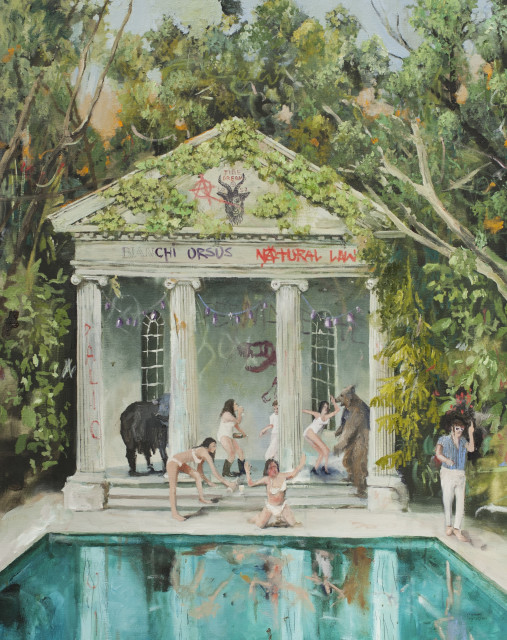Carbon 12 is delighted to announce Philip Mueller’s solo exhibition.
In the summer of 2017, the notorious Black Flamingo Sad Boys emerged from dark, woodsy pastures, to abandon the confines of their Alpine environment for the bleached sand and enticing turquoise pools of former prison-island, Santo Stefano. All inhibition was relinquished, and a seemingly endless summer was birthed in the ruminations of Philip Mueller (b.1988, Austria) where the gang established a new haven in the anti-beach resort, Beach Resort Tiberio. Knowing no home nor respite, the gang saw fit to indulge their hedonistic desires at their seemingly newfound paradise - from racing 60’s, 70’s and 80’s cult car classics, to retiring to the languorous way of life the anti-beach resort implores.
As creator of his intricate universe, Philip Mueller conceives a timely conclusion to the resort series in The Last Days of Soft Machine. Enveloped in dense greenery, every corner of the island is alight. Glasses clink sharply against one another, held up high to commemorate the end of Beach Resort Tiberio, wherein Mueller’s new paintings delineate the detrimental culmination of the Black Flamingo Sad Boys’ exhaustive lifestyle of excess, in the event of one last great celebration.
In a culture consumed by the futile pursuit of countless, short-lived pleasures, Mueller derives elements from Russian Decadence to portray overindulgent habits of the resort’s inhabitants. Influences of 19th century Romanticism pervade Mueller’s overarching body of work; from earlier depictions of lush forests and wooden cabins, to cinematic stills of smooth-edged Sardinian rocks surrounded by sweeping planes of blue sky and sea, and derelict architectural spaces of the former prison, bleached white under the heat of the sun.
Across a vast, sweeping panorama of the cacophonous celebration, we are made witness to a party occurring in slow motion and all at once. Mueller shines a harsh light on a drastic undoing of the “soft machine” - the own human body, as alluded to within William Burroughs’ novel - and like atrophy to fragile anatomy, follows its spiralling descent towards ruination. Undulating intervals of contemplation, throbbing chaos, and all that remains in between, are fleshed out within the paintings of Philip Mueller.
Akin to the nature of a nearly incomprehensible fever dream; fast, yet excruciatingly detailed - Mueller employs and accentuates rich, picturesque imagery with a heavily injected use of saturated color, to elucidate the stark contrast between grandiose illusions of opulence and their very transience. Fleeting impressions of beauty in representations of classical sculpture and idyllic sceneries are juxtaposed with acts of violence and vandalism. “Nothing can be holy that is human built,” are words as spoken by the artist.
After a screeching halt comes silence. Tarnished helmets and car debris lie still in the wake of a new era. In the stillness of the aftermath, as the dust begins to settle from the debris of a lotus-eating culture, the inevitable question of what lies beyond appears: What is next in store for the Black Flamingo Sad Boys?

